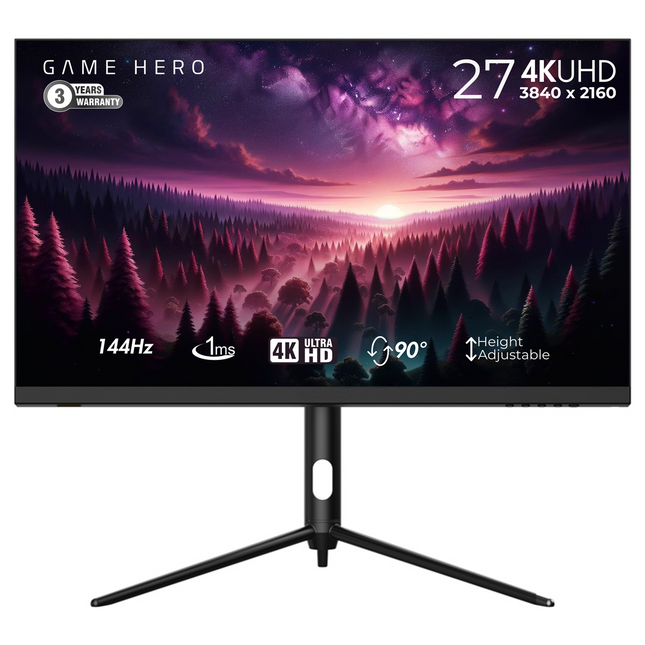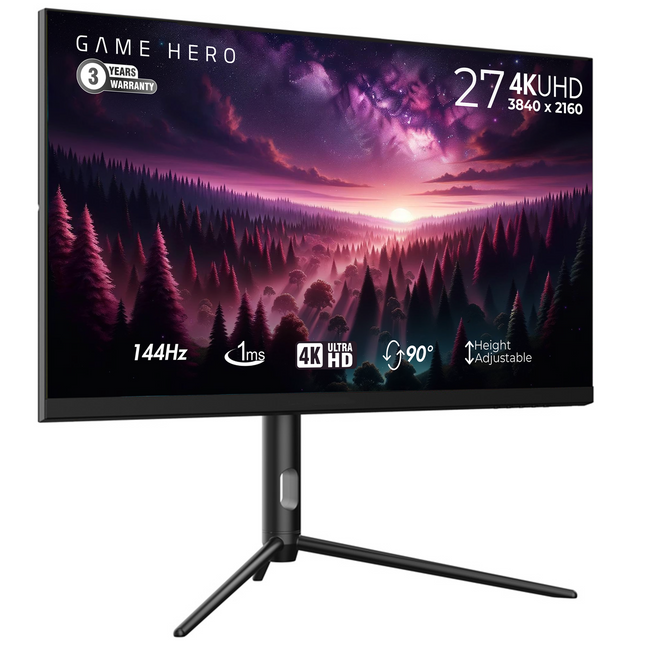How do you choose the right gaming monitor?
 Refresh rate
Refresh rate
The hertz (Hz) refers to the number of times per second the screen is refreshed. A higher refresh rate can result in smoother and more fluid motion, especially in fast-paced games or other applications. Here are the characteristics of the different monitor refresh rates:
- 60Hz: This is the default refresh rate for most monitors. It is suitable for general computing tasks, such as browsing the web, watching videos, and working with documents.
- 75Hz: A 75Hz refresh rate can provide a slight improvement in motion smoothness and reduce motion blur, making it a good option for gaming.
- 144Hz: A 144Hz refresh rate is ideal for gaming as it offers a significant improvement in motion clarity, making fast-moving objects look smoother and more natural. It is also popular for graphic design and video editing as it allows more precise and accurate movements.
- 240Hz: A refresh rate of 240Hz is the highest currently available and is primarily intended for competitive gaming. It provides the smoothest motion and minimizes input lag, making it ideal for fast-paced games where reaction time is critical.
It is important to note that the benefits of higher refresh rates may vary depending on the quality of the monitor, graphics card and application used. Plus, not all users will notice a significant difference between refresh rates, so it's worth considering cost and intended use before investing in a monitor with a high refresh rate.
 Response time
Response time
The response time of a monitor refers to the time it takes for a pixel to transition from one color to another. Lower response time generally results in less motion blur and ghosting, which can be beneficial for gaming and other high-speed applications. These are the characteristics of different monitor response times:
- 1ms: A 1ms response time is the fastest available today and offers the least amount of motion blur and ghosting. It is ideal for competitive gaming and other applications that require fast and precise movements.
- 4ms: A response time of 4ms is still relatively fast and strikes a good balance between motion blur and cost. It is suitable for most gaming and general computing tasks.
- 6ms: A 6ms response time can produce slightly more motion blur and ghosting compared to faster response times, but is still suitable for most gaming and general computing tasks.
- 10ms: A response time of 10ms is generally considered the slowest acceptable response time for most applications. This can lead to noticeable motion blur and ghosting, especially with fast-paced games or movies.
The perceived impact of response time may vary depending on the user and application. Some users may not notice a significant difference between response times, while others may be more sensitive to motion blur and ghosting. It's also important to consider other factors, such as refresh rate and input lag, when choosing a monitor for gaming or other high-speed applications.
 Screen size and ratio
Screen size and ratio
Monitor sizes and aspect ratios can have a significant impact on the user experience, especially for activities such as gaming, multimedia and productivity. Here are the characteristics of different monitor sizes and aspect ratios:
- Standard: A standard monitor usually has an aspect ratio of 4:3 and is available in sizes from 17 to 22 inches. These monitors are less common these days as widescreen formats have become more popular, but they may still be suitable for certain applications such as general computer work and basic office work.
- Wide: A widescreen monitor typically has an aspect ratio of 16:9 and comes in sizes from 23 inches to 32 inches. These monitors are popular for gaming, multimedia and productivity as they offer a larger and more immersive viewing experience compared to standard monitors.
- Ultrawide: An ultrawide monitor usually has an aspect ratio of 21:9 or 32:9 and is available in sizes from 34 inches to 49 inches. These monitors are ideal for productivity as they provide more screen real estate for multitasking and working with multiple windows. They are also popular for gaming and multimedia as they provide a more immersive viewing experience.
- 29-49 inches: Monitors in this size are usually available in wide or ultra-wide aspect ratios and are ideal for productivity, gaming, and multimedia. They offer a larger and more immersive viewing experience compared to smaller monitors and can be particularly beneficial for tasks that require a lot of detail or multiple windows.
When choosing a monitor size and aspect ratio, it's important to consider your intended use, as well as factors such as desk space, viewing distance, and budget. A larger monitor can provide a more immersive experience, but may also require a larger desk and budget.
 Screen resolution
Screen resolution
Monitor resolution refers to the number of pixels displayed on the screen. A higher resolution usually results in a sharper and more detailed image, but may also require more powerful hardware to drive the screen. These are the characteristics of the different monitor resolutions:
- FHD (Full HD): FHD refers to a resolution of 1920x1080 pixels, which is a common resolution for monitors and TVs. It strikes a good balance between image quality and affordability and is suitable for most applications, including gaming, multimedia and productivity.
- QHD (Quad HD): QHD refers to a resolution of 2560x1440 pixels, which offers a higher level of detail compared to FHD. It is ideal for productivity as it offers more screen real estate for working with multiple windows. It is also popular for gaming and multimedia as it offers a more immersive viewing experience.
- WQHD (Ultra Wide Quad HD): WQHD refers to a resolution of 3440x1440 pixels, an ultra-wide aspect ratio that offers even more screen real estate for multitasking and productivity. It is also popular for gaming and multimedia as it offers a very immersive viewing experience.
- 4K (Ultra HD): 4K refers to a resolution of 3840x2160 pixels, which provides an extremely high level of detail and is suitable for professional applications such as graphic design, video editing and 3D modeling. It is also popular for gaming and multimedia as it offers a very immersive viewing experience.
When choosing a monitor resolution, it is important to consider the intended use, hardware requirements and budget. Higher resolutions typically require more powerful hardware to drive the display, so it may be necessary to upgrade the graphics card or other components to take full advantage of the increased detail.


